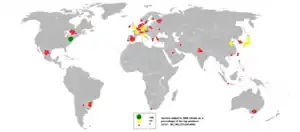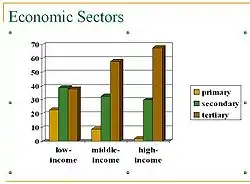Three-sector model
The three-sector model in economics divides economies into three sectors of activity: extraction of raw materials (primary), manufacturing (secondary), and service industries which exist to facilitate the transport, distribution and sale of goods produced in the secondary sector (tertiary).[1] The model was developed by Allan Fisher,[2][3][4] Colin Clark,[5] and Jean Fourastié.[6] in the first half of the 20th century, and is a representation of an industrial economy. It has been criticised as inappropriate as a representation of the economy in the 21st century.[7]
| Economic sectors |
|---|
| Three-sector model |
|
Primary sector: raw materials Secondary sector: manufacturing Tertiary sector: services |
| Additional sectors |
|
Quaternary sector: information services Quinary sector: human services |
| Theorists |
| AGB Fisher · Colin Clark · Jean Fourastié |
| Sectors by ownership |
| Business sector · Private sector · Public sector · Voluntary sector |
| Grey market and Informal economy |
|---|
| Part of a series on |
| Economic systems |
|---|
|


According to the three-sector model, the main focus of an economy's activity shifts from the primary, through the secondary and finally to the tertiary sector. Countries with a low per capita income are in an early state of development; the main part of their national income is achieved through production in the primary sector. Countries in a more advanced state of development, with a medium national income, generate their income mostly in the secondary sector. In highly developed countries with a high income, the tertiary sector dominates the total output of the economy.
The rise of the post-industrial economy in which an increasing proportion of economic activity is not directly related to physical goods has led some economists to expand the model by adding a fourth quaternary or fifth quinary sectors, while others have ceased to use the model.
Structural transformation according to Fourastié



Fourastié saw the process as essentially positive, and in The Great Hope of the Twentieth Century he wrote of the increase in quality of life, social security, blossoming of education and culture, higher level of qualifications, humanisation of work, and avoidance of unemployment.[6] The distribution of the workforce among the three sectors progresses through different stages as follows, according to Fourastié:
First phase: Traditional civilizations
Workforce quotas:
- Primary sector: 64.5%
- Secondary sector: 20%
- Tertiary sector: 15.5%
This phase represents a society which is scientifically not yet very developed, with a negligible use of machinery. The state of development corresponds to that of European countries in the early Middle Ages, or that of a modern-day developing country.
Second phase: Transitional period
Workforce quotas:
- Primary sector: 40%
- Secondary sector: 40%
- Tertiary sector: 20%
More machinery is deployed in the primary sector, which reduces the number of workers needed to produce a given output of food and raw materials. Since the food requirements of a given population do not change much, employment in agriculture declines as a proportion of the population.
As a result, the demand for machinery production in the secondary sector increases and workers move from agriculture to manufacturing. The transitional way or phase begins with an event which can be identified with the industrialisation: far-reaching mechanisation (and therefore automation) of manufacture, such as the use of conveyor belts. The tertiary sector begins to develop, as do the financial sector and the power of the state.
Third phase: Tertiary civilization
Workforce quotas:
- Primary sector: 10%
- Secondary sector: 20%
- Tertiary sector: 70%
The primary and secondary sectors are increasingly dominated by automation, and the demand for workforce numbers falls in these sectors. It is replaced by the growing demands of the tertiary sector, where productivity growth is slower. [8]
Extensions to the three-sector model
Further development has led to the service or post-industrial society. Today the service sector has grown to such an enormous size that it is sometimes further divided into an information-based quaternary sector, and even a quinary sector based on human services.
Quaternary sector
The quaternary sector, sometimes referred to as the research and development sector, consists mainly of businesses providing information services, intellectual activities and knowledge based activities aimed at future growth and development.
Activities include, and are mainly composed of: scientific research, ICT/computing, education, consulting, information management and financial planning.
Contrary to what might be inferred from the naming convention, the quaternary sector doed not add value to the outputs of the tertiary sector, but provides services directly with limited reliance on purchased inputs. The output of the quaternary sector is difficult to measure. The volume of information produced has grown rapidly, in line with Moore's Law.[9]
Quinary sector
The quinary sector is the sector that focuses on human services and control, such as government and some charities, as well as creation or non-routine use of information and new technologies, linking slightly with the quaternary sector.[10]
Sometimes referred to as ‘gold collar’ professions,[11] they include special and highly paid skills of senior business executives, government officials, research scientists, financial and legal consultants, etc. The highest level of decision makers or policy makers perform quinary activities.[10]
Value added, national accounts and the three sector model
The three sector model was closely related to the development of national accounts, notably by Colin Clark. The concept of value added is central to national accounting. Value added in the secondary sector of the economy (manufacturing) is equal to the difference between the (wholesale) value of goods produced and the cost of raw materials supplied by the primary sector. Similarly, the value added by the tertiary sector is equal to the difference between the retail price paid by consumers and the wholesale price paid to manufacturers.
The concept of value added is less useful in relation to the quaternary and quinary sectors.
See also
References
- Kjeldsen-Kragh, Søren (2007). The Role of Agriculture in Economic Development: The Lessons of History. Copenhagen Business School Press DK. p. 73. ISBN 978-87-630-0194-6.
- Fisher, Allan G. B. (1935). The Clash of Progress and Security. London: Macmillan. Retrieved 2019-07-13.
- Fisher, Allan G. B. (1939). "Production, primary, secondary and tertiary". Economic Record. 15 (1): 24–38. doi:10.1111/j.1475-4932.1939.tb01015.x. ISSN 1475-4932.
- Fisher, Allan G. B. (1946). Economic Progress And Social Security. London: Macmillan. Retrieved 2019-07-14.
- Colin Clark (1940). The Conditions of Economic Progress. London: Macmillan. Retrieved 2019-07-13.
- Fourastié, Jean (1949). Le grand espoir du XXe siècle: Progrès technique, progrès économique, progrès social (in French). Paris: Presses universitaires de France.
- Schafran, Alex; McDonald, Conor; López-Morales, Ernesto; Akyelken, Nihan; Acuto, Michele (2018). "Replacing the services sector and three-sector theory: urbanization and control as economic sectors". Regional Studies. 52 (12): 1708–1719.
- Baumol, William (1967). "Macroeconomics of unbalanced growth: The anatomy of urban crisis". American Economic Reviw. 57 (47): 415–26.
- Quiggin, John (2014). "National accounting and the digital economy". Economic Analysis and Policy. 44 (2): 136–142. doi:10.1016/j.eap.2014.05.008.
- Kellerman, Aharon (1985-05-01). "The evolution of service economies: A geographical perspective 1". The Professional Geographer. 37 (2): 133–143. doi:10.1111/j.0033-0124.1985.00133.x. ISSN 0033-0124.
- "Sectors of Economy: Primary, Secondary, Tertiary, Quaternary and Quinary". 2014-10-05.
Further reading
- Bernhard Schäfers: Sozialstruktur und sozialer Wandel in Deutschland. ("Social Structure and Social Change in Germany") Lucius und Lucius, Stuttgart 7th edition 2002
- Clark, Colin (1940) Conditions of Economic Progress
- Fisher, Allan GB. Production, primary, secondary and tertiary. Economic Record 15.1 (1939): 24-38
- Rainer Geißler: Entwicklung zur Dienstleistungsgesellschaft. In: Informationen zur politischen Bildung. Nr. 269: Sozialer Wandel in Deutschland, 2000, p. 19f.
- Hans Joachim Pohl: Kritik der Drei-Sektoren-Theorie. ("Criticism of the Three Sector Theory") In: Mitteilungen aus der Arbeitsmarkt- und Berufsforschung. Issue 4/Year 03/1970, p. 313-325
- Stefan Nährlich: Dritter Sektor: "Organisationen zwischen Markt und Staat." ("Third Sector: Organizations Between Market and State"). From "Theorie der Bürgergesellschaft" des Rundbriefes Aktive Bürgerschaft ("Theory of the Civil Society" of the newsletter "Active Civil Society") 4/2003
- Uwe Staroske: Die Drei-Sektoren-Hypothese: Darstellung und kritische Würdigung aus heutiger Sicht ("The Three-Sector-Hypothesis: Presentation and Critical Appraisal from a Contemporary View"). Roderer Verlag, Regensburg 1995